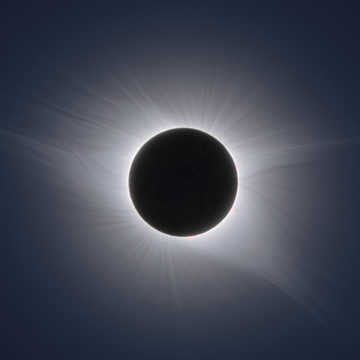Whether cloudy skies or airfare prevent you from seeing the total solar eclipse on July 2nd, you can still see totality via one of the multiple webcasts we compile here.

Sky & Telescope / Sean Walker
There's nothing like seeing a total solar eclipse in person. It's a full sensory experience, from the chill in the air to the sounds (or sudden quiet) of animals reacting to unexpected darkness. Even normal daylight takes on a silvery quality as the eclipse progresses. Then there's the experience of totality itself — witnessing the black hole that appears where the Sun ought to be, surrounded by its white halo that's normally hidden from view.
But we can't all be so lucky, at least not every time. The total solar eclipse on July 2, 2019, will pass over the South Pacific, Chile, and Argentina — a long way to go if you're not from that part of the world. Fortunately, the internet's got our respective backs: There are multiple livestreams offering views of totality. Here's a selection that ought to offer quality views.
Live Feeds of Totality on July 2, 2019
- The Exploratorium in San Francisco is offering a live stream of the eclipse from the Cerro Tololo Observatory in Chile from 3:23 p.m. until 5:46 p.m. EDT. Experience totality from the museum's website, the free iOS and Android apps, or come to the museum to see the big-screen broadcast. In addition to other eclipse programming, the Exploratorium will feature data-driven sonification of live telescope images by composer Wayne Grim.
- La Silla Observatory will host a live feed through three small telescopes, including occasional views of spectators at the observatory. This feed will not include commentary.
- NASA is partnering with Exploratorium to carry out its own livestream of the eclipse, offering the same views as Exploratorium while also giving updates on the Parker Solar Probe and Magnetospheric Multiscale missions. NASA will have three different livestreams available: Live telescope views without audio from 3 p.m. to 6 p.m. EDT, an English-language program from 4 to 5 p.m., and a Spanish-language program, also from 4 to 5 p.m. The English-language program will also be available on NASA TV.
- Slooh Observatory is presenting a live viewing of the event from on their website, between 3:15 p.m. and 5:50 p.m. EDT. They will also host the event on their Facebook page.
- An additional Spanish-language webcast will be available via SKY Live TV.
- TimeandDate.com will host a webcast on its website.
 4
4









Comments
Acugnini
July 2, 2019 at 11:24 am
It is disappointing to see the short shrift the 2019 eclipse has been given in the print version of S&T. Aside from two paragraphs in the July 2019 issue, there has been none of the standard pre-eclipse coverage, such as maps (always beautiful in and of themselves) or eclipse timings, etc.
One can attribute this to two things: (1), ever-shrinking story space; and (2) an "Americentric" focus of celestial events, intentional or not. Notwithstanding the rather short landfall of the eclipse, the path nonetheless skirts Buenos Aires, the largest city and capital of Argentina, and the second largest metropolitan area in South America.
According to the Global Cities Index, Buenos Aires is repeatedly ranked as the top city in Latin America; out of the 125 cities evaluated globally on business activity, human capital, information exchange, cultural experience and political engagement, Buenos Aires places at number 21.
Certainly, an expansive coverage is not expected, and the online site has plenty of information. But to omit nearly all coverage from the magazine ignores an important event from a continent that seems to get astronomical attention mostly for Cerro Tololo – an inter-American facility – and similar sites.
-- agc
You must be logged in to post a comment.
Monica Young
July 2, 2019 at 12:38 pm
Responding on the behalf of the editors of Sky & Telescope: "This total solar eclipse is not well-placed for the majority of our largely Northern Hemisphere print readership. (Note that Southern Hemisphere readers have the option of subscribing to the Australian edition of Sky & Telescope, which has a corresponding focus on southern skies.) So, due to the limited pages in the print magazine, we chose to feature most of our material about this total solar eclipse online."
You must be logged in to post a comment.
diegonicolosi
July 2, 2019 at 10:48 pm
I would like to submit coverage of the solar eclipse over the pampas of Argentina, but I can't seem to find the way. Could you help me please? Thanks
You must be logged in to post a comment.
Monica Young
July 3, 2019 at 9:29 am
We're working on posting that now - I'll leave the link here as soon as it's live.
Edited to add: Here's the link: https://skyandtelescope.org/astronomy-news/2019-totality-report/
You must be logged in to post a comment.
You must be logged in to post a comment.